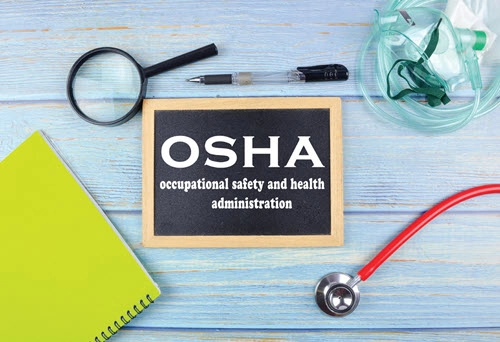Bolster COVID ETS Compliance With These 9 Steps
Tip: Your hazard assessment must get specific. The Occupational Safety and Health Administration (OSHA) recently offered fresh guidance on COVID-19 emergency temporary standards as well as hefty requirements for healthcare providers. While OSHA says it will use enforcement discretion for healthcare providers acting in good faith that start following the new regs, savvy providers would be wise to bring their compliance up-to-speed ASAP. Details: OSHA released the long-awaited emergency temporary standards (ETS) rule on June 10, but compliance deadlines were based on the rule’s publication in the Federal Register. That official publication date was June 21, meaning the requirements with 14-day dates were effective July 5 while the 30-day dates aren’t effective until July 21. Breakdown: July 5 deadlines include those for a COVID-19 plan; paid leave; personal protective equipment (PPE); anti-retaliation protections; a COVID-19 log; reporting COVID-19-related hospitalizations and fatalities to OSHA; and employee notification of other worker cases, point out attorneys Courtney Malveaux, Jennifer Bologna, and Patricia Anderson Pryor with law firm Jackson Lewis. July 21 deadlines include those for employee training; physical workstation barriers; and effective ventilation, Malveaux, Bologna, and Anderson Pryor say in online analysis. Though the lion’s share of COVID-19 ETS requirements started July 5, there are still a few that become effective July 21. Some of the requirements overlap with guidance from the Centers for Disease Control and Prevention (CDC), Centers for Medicare & Medicaid Services (CMS), and other regulatory bodies. But a chunk of the mandates will be new, including notice, recordkeeping, reporting, training, and paid leave requirements. Whether your compliance was already in check by the July 5 effective date — but it still needs tweaked for the July 21 round of requirements — or you’re still scrambling to meet the ETS demands, follow this advice from legal experts to make sure you don’t leave yourself open to OSHA inspections and penalties: 1. Determine Whether the Rule Applies to You The ETS interim final rule spells out a long list of new requirements, but some or all may not apply to you, based on your size, degree of worker and patient vaccination, and other factors. “Employers in the health care industry should immediately determine whether they are covered by the ETS,” urge attorneys Nathaniel Glasser, Philip Lamborn, and Robert O’Hara with law firm Epstein Becker & Green in online analysis. You can use the flowchart from OSHA at www.osha.gov/sites/default/files/publications/OSHA4125.pdf to help determine coverage. 2. Double-Check State Requirements Four OSHA “State Plan” states have enacted their own COVID-19 standards, Malveaux, Bologna, and Anderson Pryor point out. The four states that set up their own standards include California, Michigan, Oregon, and Virginia. For example, California OSHA already revised its stringent standards regulation on June 17, in light of the federal rule. “Healthcare employers … will need to be aware of the myriad state and local requirements relating to COVID-19 in healthcare settings” and determine which ones they must comply with, advise the Jackson Lewis lawyers. “Compliance with the ETS does not relieve employers from complying with applicable state or local government mandates,” caution attorneys Megan Baroni, Lisa Boyle, Conor Duffy, and Jonathan Schaefer with law firm Robinson & Cole in online analysis. 3. Revamp Policies and Procedures ASAP Healthcare providers don’t have much time to get their compliance in check. “OSHA had previously only issued non-mandatory guidance on COVID-19 workplace safety practices and procedures, relying instead on existing PPE and general safety standards to address workplace safety issues raised by the coronavirus pandemic,” note attorneys Guy Brenner and Alexandra Rueckle Reynolds with law firm Proskauer in online analysis. “With this ETS, covered employers in the healthcare setting may need to adjust their policies and practices to comply with these new nationwide standards.” 4. Develop Your COVID-19 Plan Providers must develop and implement a COVID-19 plan (in writing if more than 10 employees) that includes a designated safety coordinator with authority to ensure compliance; a workplace-specific hazard assessment; involvement of non-managerial employees in hazard assessment and plan development/ implementation; and policies and procedures to minimize the risk of transmission of COVID-19 to employees, OSHA says in its fact sheet on the ETS interim final rule. Do this: “Identify the key stakeholders, including appropriate non-managerial employees, to develop a COVID-19 plan,” the Epstein Becker attorneys counsel. Important: Your employee training must identify the safety coordinator identified in your plan, the Jackson Lewis attorneys highlight. See OSHA’s plan template at www.osha.gov/coronavirus/ets under “Implementing the ETS.” 5. Conduct a Hazard Assessment Address the workplace hazard requirement promptly, urge the Epstein Becker attorneys. “Healthcare employers [must] conduct a workplace-specific hazard assessment to identify potential workplace hazards related to COVID-19,” OSHA spells out in the rule. “Employers have flexibility to determine the best approach to accomplish the overall hazard assessment,” OSHA says in its ETS Frequently Asked Questions (FAQs) document. “However, the hazard assessment must include an evaluation of employees’ potential workplace exposure to all people present at the workplace, including patients, coworkers, employees of other entities, members of the public, clients, independent contractors, visitors, and other non-employees.” More details about conducting the hazard assessment are in FAQ No. 7 at www.osha.gov/coronavirus/ets/faqs. 6. Tee Up Staff Training Don’t assume you are covered if you have already been training employees on COVID. “Prepare a COVID-19 training program for employees, or, if training has already been given, review the prior training to ensure it meets all ETS requirements,” the Epstein Becker attorneys advise. Training is supposed to cover new items such as the identity of your safety coordinator, the new removal and paid leave benefits, and more. “The employer must also ensure that the training is provided, or overseen, by an individual knowledgeable in the subject matter as it relates to the employee’s job duties, and is interactive, providing the employee an opportunity to ask the trainer questions,” advise attorneys Edward Cadigan, Ashley Steiner Kelly, Megan Mitchell, and Henry Perlowski with law firm Arnall Golden Gregory in online analysis. 7. Start the Compliance Process — Yesterday There’s no time to waste. “Employers subject to the ETS will want to act quickly to ensure full compliance,” the Robinson & Cole attorneys urge online. “Although OSHA emergency temporary standards have a history of being struck down by courts, covered health care employers should not hesitate before taking steps to ensure compliance with OSHA’s COVID-19 ETS,” Hall Render urges. “OSHA has received a substantial influx of cash and resources under the Biden administration, which will no doubt lead to increased inspections and related enforcement activities.” Bottom line: “Health care employers need to be ready,” Hall Render stresses. 8. Keep Up the Effort You won’t be able to implement a plan and then call it a day. “Compliance with the ETS and other relevant OSHA standards and guidance will require careful attention and continued focus in order to ensure that employees are being provided a safe workplace free from recognized hazards,” the Robinson & Cole lawyers emphasize. 9. Keep an Eye on Developments Litigation over the ETS is widely expected. “As with previous ETSs, the current ETS may be the subject of legal challenges seeking a stay or outright invalidation,” the Arnall Golden lawyers expect. “OSHA has promulgated nine ETSs prior to this one, but not for decades,” point out attorneys Mark Duvall, Heidi Knight, and Jayni Lanham with law firm Beveridge & Diamond. The last ETS came in 1983. “ETSs have not fared well in court challenges,” Duvall, Knight, and Lanham note in their online analysis. “Five were stayed or vacated, at least in part.” Legal developments likely won’t be the only ones. OSHA may clear up a number of gray areas through subregulatory channels. “Monitor OSHA’s website for more updated guidance,” the Epstein Becker lawyers recommend. Resource: The 253-page ETS interim final rule is at www.govinfo.gov/content/pkg/FR-2021-06-21/pdf/2021-12428.pdf. Comments are due July 21.


